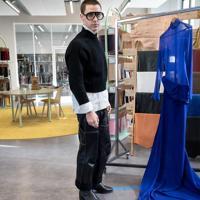Fashion
Giving a second life to fashion’s deadstocks

PARIS
At the Nona Source showroom in northern Paris, designers pick through luxurious textiles with ornate names: curly alpaca, geometrical macrame guipure, silk diamond cloque Jacquard.
What makes them really exotic, however, is that they all come from “deadstocks,” the leftovers designers discard when they have finished with a roll of fabric.
Until recently, it was common for deadstocks, like unsold clothes, to be burned or buried. At best, they gathered dust in storerooms.
Ever conscious of its image, luxury giant LVMH set up Nona Source three years ago, selling deadstocks at a sizeable discount to up-and-coming designers.
“I realised there were what we call ‘sleeping beauties’ in the depots, magnificent fabrics that were lying there for years after collections were made,” said co-founder Romain Brabo.
Last year, it sold some 280 kilometres (170 miles) of fabric, enough for roughly 140,000 items of clothing.
Among the regular customers is Arturo Obegero, a 30-year-old Spanish designer who uses only upcycled and recycled materials.
Despite working out of a small space in his house, he has scored some big-name orders including a sheer corset dress for Beyonce on her Renaissance tour, a sign of his skill and the increasing attraction of climate-conscious design.
“I come from a family of surfers, of fishermen. When you come from a small town, you’re connected to nature, you learn to respect it,” said Obegero.
He says Nona Source has allowed him to work in the big leagues.
“People are more conscious about which products they purchase… but it can be complicated to offer something really sustainable at an affordable price.”
As pressure mounts on the fashion industry to manage its mountains of waste and massive ecological impact, initiatives like Nona Source are multiplying.
Luxury behemoths like LVMH can afford to make an effort, and also understand the marketing value.
It has ambitious aims such as shifting transport from planes to boats, training suppliers in better water-management, and investing in tech-driven new textiles like vegan leather (it says it tested 300 such innovations last year).
But Helene Valade, LVMH’s head of sustainability, says the company’s main role is to “evolve” people’s understanding of beauty.
“That’s really our power. Ten years ago when we wore something recycled, people found it ugly. That’s no longer the case,” she told AFP.
“Beauty is no longer something that is completely smooth, perfect, straight… It’s also what designers can do with recycled fabrics.”
Some are sceptical.
“Until they get PVC plastic out of their supply chain, especially at Louis Vuitton, LVMH will never be a green company,” said Dana Thomas, author of “Fashionopolis” about the industry’s climate impact.
Louis Vuitton, the world’s biggest-selling luxury brand, makes most of its money from its monogrammed bags, which are made from PVC-coated canvas.
Thomas welcomes ideas like Nona Source, but finds it frustrating.
“It’s a sensible idea. So why weren’t they already doing this 20 years ago?” she said.
“Fashion is so behind compared to, say, the automobile industry. You can now buy an electric truck, but bags are still made from plastic?!”
She says a new generation of fashion executives are finally paying attention, and Nona Source is seeing the impact as an increasing amount of the deadstock it receives is already made from recycled textiles.
“We are seeing a real major change,” said Brabo.
As he spoke to AFP, in walked Charles de Vilmorin, the 27-year-old prodigy who was creative director for Rochas and runs his own Paris label.
“I come here for inspiration. I like to be surprised,” said De Vilmorin.
“I find it wonderful that they give new life to these materials, that they are not thrown away or destroyed… It’s very important.”









